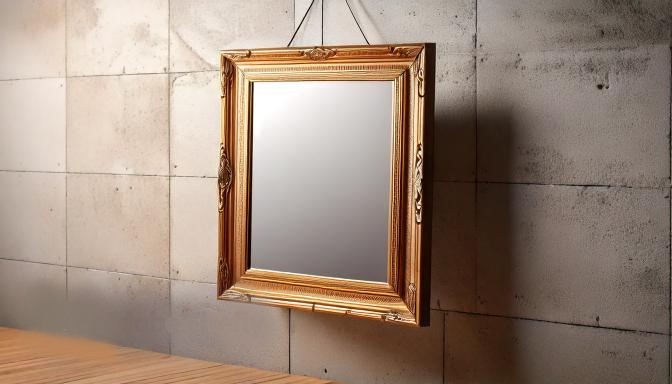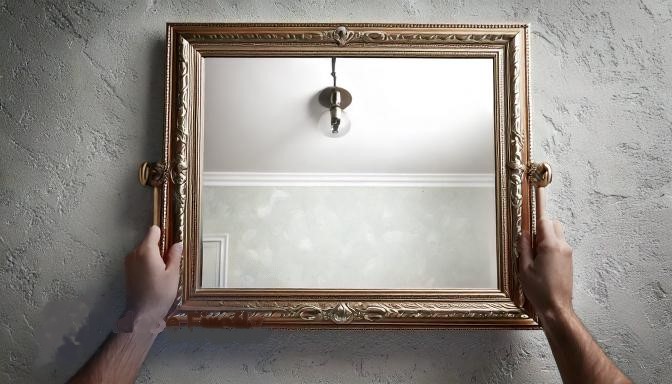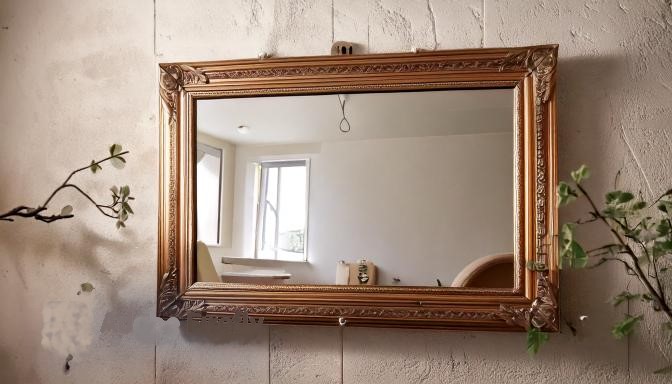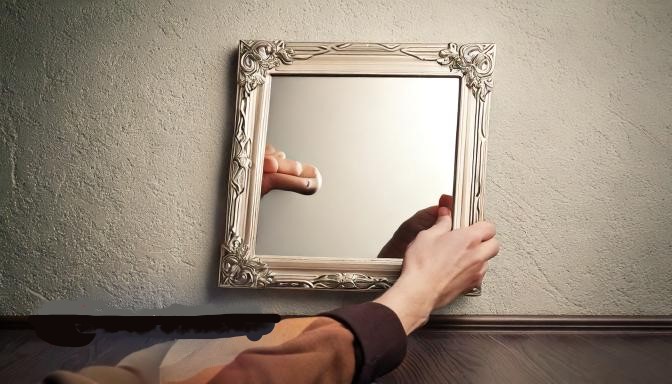
Heavy mirrors require careful preparation and precise methods to prevent wall damage. You should learn how to hang heavy mirror on drywall. This avoids costly accidents and creates secure, professional displays. Any DIY enthusiast can tackle this with the right tools, hardware, and installation techniques.
This comprehensive guide shows everything needed for how to hang a heavy mirror on drywall without studs. You’ll find the quickest way through easy steps covering weight limits, wall prep, and safety precautions. The content helps avoid common errors, offering expert advice for a secure, lasting installation.
Gather the Necessary Tools and Materials for how to hang heavy mirror on drywall
You need the proper tools, equipment, and safety gear to hanging a heavy mirror on drywall properly. Having all the necessary items will make the installation go smoothly and prevent common mistakes.
Essential tools
Precise measuring and layout gear is key for successful mirror installation. A tape measure and level are vital for accurate positioning. You’ll need a pencil or chalk line to mark the installation points too. For hanging a heavy mirror on drywall, make sure you have these tools on hand:
- Stud finder to locate wall supports
- Drill with appropriate bits
- Phillips head screwdriver
- Tape measure and level
- Pencil or chalk line marker
- Laser level (for large mirrors)
Required hardware
Correct mounting hardware is vital for how to hang a heavy mirror on drywall without studs. A mirror’s weight and wall type determine the ideal hardware. This guide outlines common mounting options and their weight limits:
| Hardware Type | Weight Capacity | Best Use Case |
|---|---|---|
| Toggle Bolts | Up to 50 lbs | Drywall without studs |
| D-rings | 25-40 lbs | With hanging wire |
| French Cleats | Up to 200 lbs | Large heavy mirrors |
| Mirror Clips | 30-65 lbs | Frameless mirrors |
Best way to hang heavy mirror on drywall requires special steps. Heavy-duty anchors or cleats provide multiple support spots. Metal cleats evenly spread weight. These work in pairs – one piece connects to the wall while its partner secures the mirror’s frame.
Safety equipment
Proper protection is required for how to hang heavy mirror on drywall. The right safety gear shields you from injuries during this process. Key safety gear includes the following items:
Sturdy work gloves protect your hands, guarding against sharp edges and providing better grip. Protective eyewear ensures debris does not enter your eyes while drilling, and a dust mask prevents inhaling wall particles. For larger mirrors, a back brace can help prevent strain when lifting.
When using adhesives or chemical anchors, ensure adequate ventilation to maintain good airflow. Tidiness in your workspace minimizes accident risks. Proper lighting helps you identify and avoid hazards throughout the installation process.

Determine the Mirror’s Weight and Wall Type
Figuring out the mirror’s weight and checking the wall are crucial for how to hang heavy mirror on drywall safely. Taking these measurements lets you pick the proper hardware and best way to install it securely.
Weighing the mirror
Selecting the right mounting solution hinges on calculating the mirror’s weight precisely. A standard equation aids in determining the mirror’s weight accurately:
| Mirror Thickness | Weight per Square Foot |
|---|---|
| 1/8 inch | 1.64 lbs |
| 1/4 inch | 3.27 lbs |
| 3/8 inch | 4.91 lbs |
The entire weight computation demands multiplying the mirror’s area (length multiplied by width) by the weight per square foot. Don’t forget to include the frame’s weight, if your mirror possesses one. Mirrors with bevelled edges have more weight compared to their non-bevelled counterparts of identical size.
Identifying drywall
Before learning how to hang a heavy mirror on drywall without studs, you have to verify your wall type. Most modern homes feature drywall displaying these distinct traits:
- A hollow sound appears after knocking
- A pushpin penetrates the surface easily
- Paper backing becomes visible while perusing electrical outlets
- The thickness stays uniform at about 1/2 inch
- The surface texture remains consistent
Locating wall studs
The best way to hang heavy mirror on drywall first. These vertical studs occur every 16 or 24 inches. You can begin your search near corners or electrical outlets, as they attach to studs. A stud finder provides reliable results, but other methods work too.
My preferred technique is knocking on walls, listening for solid spots among hollow spaces. The sound shifts from hollow to solid when encountering a stud. Measuring 16 inches from any confirmed stud locates the next one. Heavy mirrors need at least one stud for proper support, especially with significant weight involved.
Professional installers recommend checking multiple spots up and down to verify the stud’s location before drilling. Doing so helps ensure you’ve found an actual stud, not a pipe or electrical conduit.
Choose the Appropriate Hanging Method
Securely installing for hanging a heavy mirror on drywall on selecting the proper mounting method during planning. Diverse mounting choices offer varying advantages, contingent upon your mirror’s dimensions, weight, and frame style.
| Mounting Method | Weight Capacity | Best For |
|---|---|---|
| D-rings | Up to 200 lbs | Framed mirrors |
| French cleats | 50-400 lbs | Large mirrors |
| Mirror clips | Up to 20 lbs | Frameless mirrors |
D-rings and wire
Using D-rings is a best way to hang heavy mirror on drywall. When installed properly, a pair can hold up to 200 pounds. The installers should place the rings an equal distance from the top edge of the frame, so the mirror hangs leveled. To boost stability, professionals suggest: using wire of suitable gauge weight for the mirror, attaching two wall hangers to spread out weight evenly, and securing D-rings firmly into the frame using right screws.
- Gauge wire to match mirror’s heft
- Two hangers mount for distributing equal weight
- Attach rings with secure screws in frame
French cleats
Hanging a heavy mirror on drywall, French cleats are the best solution. This aluminum two-piece system interlocks the wall and mirror. French cleats offer these key advantages: easy installation; secure, stable hanging; invisibility once mirror’s in place; adjustability for perfect alignment. The cleat provides a strong connection supporting significant weight while being low-profile.
- Support capacity ranging from 50

Prepare the Wall and Mirror
Proper preparation of walls and mirrors is key for secure, long-lasting installation. For professionals, initial steps significantly impact results when learning how to hang heavy mirror in drywall.
Marking the hanging spot
For hanging a heavy mirror on drywall, begin with precise marking for a solid, level foundation. Use painter’s tape to mark the mirror’s top edge position. Level the tape with a bubble level centered perfectly. Consider these ideal measurements:
| Room Type | Recommended Height |
|---|---|
| Living Areas | 57-65 inches from floor |
| Over Furniture | 6-12 inches above piece |
| Bathrooms | 60-72 inches from floor |
Cleaning the wall surface
Preparing the wall surface carefully is crucial for hanging a heavy mirror on drywall. The structural soundness and cleanliness help bear the weight properly. Seasoned installers endorse these techniques:
- Dusting off debris using a clean, dry cloth proves effective.
- Delicate sanding renders a smooth, even finish by ironing out bumps.
- Warm water sufficiently cleanses the area; ensure absolute drying before proceeding.
- Maintain an ambient temperature between 60-85°F during the whole installation process.
- Unpainted drywall necessitates primer application as a precautionary first coat.
Attaching hardware to the mirror
Installing a large mirror onto drywall needs secure hardware. Look for existing mounting points at the mirror’s rear. If installing new hardware, precise measurements ensure even weight distribution. D-rings are ideal, placed equal distances from top and sides – one-fourth of the total height from upper edge.
For frameless mirrors, high-quality clips offer reliable attachment. Space the clips evenly along edges, with one clip every 12-16 inches. Adhesive mounting systems require a staggered pattern on mirror’s back. Keep adhesive 2-3 inches from edges to prevent seepage.
Room temperature significantly impacts hardware attachment. The range of 60-85°F is optimal – allowing proper curing of adhesives and expansion rates for metals. Your mounting hardware remains secure under normal household conditions within this temperature range.
Install Wall Anchors and Hanging Hardware
Hanging a heavy mirror on drywall gets really important when fixing anchors and bolts. This process needs great care and being correct, so the mirror stays tight and safe.
Making the first small holes
Making right small holes is very important when learning how to hang heavy mirror in drywall without the wood beams inside. How good the anchor works depends on the holes being the exact right size:
| Anchor Type | Pilot Hole Size | Weight Capacity |
|---|---|---|
| Plastic Anchors | 1/4 inch | 75 pounds |
| Toggle Bolts | 1/2 inch | 230 pounds |
| Self-Drilling | No pilot needed | 50 pounds |
Drill pilot holes perpendicular to the wall’s surface. Mark spots with a pencil beforehand. That way, you don’t miss your targets. Carefully measure twice before drilling any holes. Wear safety glasses throughout the process. Drywall dust flying around could hurt your eyes.
Inserting drywall anchors
The best way to hang heavy mirror on drywall requires proper anchor selection based on your mirror’s weight. Here’s how to install anchors correctly:
- Remove all debris from pilot holes
- Push the anchor with light pressure
- Use a hammer to tap it flush with the wall
- Make sure the anchor remains straight
- Check the anchor’s stability before moving forward
Toggle bolts work best for hanging a heavy mirror on drywall. These anchors create a strong mechanical connection. They do so by expanding behind the wall. First, push the complete assembly through the wall with the wings folded. Then pull back so the wings lock against the wall’s inner surface.
Securing screws or hooks
The final step to secure for hanging a heavy mirror on drywall is proper screw positioning. Around 1/4 inch of screw should protrude from the wall for attaching hanging hardware. Consider these expert recommendations:
- Utilize screws provided with anchors.
- Tighten screws snugly, avoiding over-tightening.
- Incrementally test weight capacity before final installation.
- Incorporate extra support points if necessary.
Toggle bolts require outward force when tightening screws to ensure wings expand fully. Insert self-drilling anchors flush with wall, then slightly retract to create space for hanging.
Multiple support points necessitate consistent screw depth to evenly distribute weight and maintain mirror alignment. Experts advise testing each mounting point individually preceding full mirror installation.

Hang the Mirror Safely
Mirrors require safe handling during installation for long-lasting stability. Expert knowledge ensures proper lifting and securing techniques. Following safety rules leads to safer results that endure.
Lifting techniques
Hanging a heavy mirror on drywall demands collaboration and careful body positioning. Mirrors weighing over 40 pounds necessitate teamwork with two people on opposing mirror sides. Lifters must maintain straight backs and bend knees while lifting together.
Safety Protocol for Mirror Lifting:
- Bring the mirror near when lifting it up
- Teammates must speak plainly as the task goes on
- Pick platform ladders, not step ones, to get up high
- Take off rings and jewels so surfaces don’t get scratched
- Spotters need smart placing to stop the mirror tipping over
Leveling the mirror
Learning for how to hang heavy mirror on drywall, It’s not an easy task. It needs care and the right technique to align it perfectly. These steps will guide you through:
- Hold the mirror against the mounting hardware, without letting its weight rest fully.
- Check if the initial position is level, using a laser level or regular one.
- While supporting the mirror’s weight, make small adjustments as needed.
- Ensure both the top and bottom edges are perfectly level.
- Let the mounting hardware slowly take on the mirror’s full weight.
Mirrors are heavy, so using multiple support points is crucial. Following recommendations help distribute the weight evenly:
| Mirror Width | Support Points | Weight Per Point |
|---|---|---|
| Under 24″ | 2 points | 50% each |
| 24-48″ | 3 points | 33% each |
| Over 48″ | 4+ points | 25% each |
Securing additional support
Heavy mirrors require extra safety measures when mounting on drywall without studs. Professionals recommend supplementing the original mount with additional support systems. These may include:
- Installing support brackets underneath
- Adding clips at mirror corners
- Applying safety straps for leaned mirrors
- Implementing secondary anchor points
Mirrors weighing over 65 pounds need a support ledge beneath. This ledge distributes weight evenly across the wall surface, providing stability. A critical safety check: Monitor the installed mirror for 24 hours before removing temporary supports or safety straps.
Your success with how to hang heavy mirror on drywall depends on proper weight distribution and secure mounting. Ensure all mounting points share equal weight and the mirror sits flush against the wall. Regular checks in the first week will reveal any settling requiring adjustment.
Professionals stress keeping steady pressure while hanging the mirror. Uneven weight distribution could damage mounting hardware. Large mirrors benefit from temporary support blocks, aiding positioning during final adjustments.

Common Mistakes to Avoid
Skilled workers know that learning how to hang heavy mirror on drywall requires understanding pitfalls prevents costly mirror installation errors. Following the appropriate technique is safer and quicker. Hanging heavy mirrors on drywall requires knowledge of common mistakes. The right process results in a secure outcome and saves effort.
Not Using a Stud Finder
Improperly using or skipping the stud finder can lead to unstable installations. Hanging a heavy mirror on drywall requires proper use of a stud finder, which includes the following:
- You must calibrate the device before each use. Even if it was calibrated before, you need to calibrate it again.
- Move the finder slowly across the wall. Don’t rush or move it too quickly.
- Mark both edges of the stud, not just the center. This gives you a better idea of the stud’s location.
- Scan the wall multiple times to verify your readings. Don’t rely on just one pass.
- Check the wall for electrical wiring before marking stud locations. You don’t want to hit any wires.
Expert installers recommend scanning the mounting area several times to map all available studs. This comprehensive approach provides the best anchor placement options for how to hang a heavy mirror on drywall without studs.
Using Inadequate Hardware
Incorrectly picking hardware could make your system less secure. Here are common mistakes you should avoid:
| Hardware Type | Common Error | Correct Usage |
|---|---|---|
| Wall Anchors | Using lightweight plastic | Choose metal toggles for heavy mirrors |
| Mounting Wire | Undersized gage | Match wire gage to mirror weight |
| Support Brackets | Too few mounting points | One bracket per 16-24 inches |
| Mirror Clips | Incorrect size | Must cover 1/3 of mirror thickness |
The best way to hang heavy mirror on drywall needs fitting hardware to the weight. Follow these key steps professionals recommend:
- Add 20% extra capacity past calculated load as a safety buffer.
- Distribute support via multiple anchoring points.
- Pick high-grade commercial mounting hardware.
- Double-check all components meet weight ratings.
- Install backup support systems too.
Skipping Leveling and Measurement Checks
When hanging a heavy mirror on drywall, precise measurements and proper leveling are crucial. However, many individuals commit common measurement mistakes:
- Not considering frame thickness
- Neglecting wall squareness checks
- Skipping multiple measurement points
- Rushing through level checks
- Missing reference line marks
Experienced installers emphasize the importance of verifying measurements meticulously:
- Take measurements at three different heights
- Ensure both top and bottom edges are level
- Leave room for expansion gaps at edges
- Record all measurements before drilling
- Use laser levels for large installations
Room temperature must remain stable during mounting, as extreme temperatures can affect adhesive performance and metal expansion. Environmental factors like humidity and wall surface conditions will impact the mirror’s long-term stability.
Prior to selecting a mounting system, ensure your wall can support it. You should:
- Check wall thickness and composition
- Inspect for moisture issues
- Verify surface solidity
- Assess overall wall condition
- Test each anchor point individually
Professional installers understand that proper preparation and patience are paramount. Rushing any step risks making dangerous mistakes. Large or heavy mirrors require extra caution:
- Choose moderate temperature days for installation
- Allow proper drying time for adhesives used.
- Install momentary bracing until fully secured.
- Inspect mounting spots thoroughly prior to final positioning.
- Schedule recurring upkeep evaluations rout
Successful hanging a heavy mirror on drywall requires meticulous planning and execution to avoid common pitfalls. Maintain detailed records regarding hardware specifics and mounting locations – vital information for future reference.
Conclusion
Hanging a heavy mirror on drywall necessitates precise weight calculations, appropriate hardware selection, and precise mounting techniques. When installed correctly, professional mounting systems can securely support up to 200 pounds on drywall. Prioritizing safety is paramount, from wall preparation to final installation steps. Utilizing the proper tools and compatible mounting hardware ensures mirror stability.
By learning of how to hang heavy mirror on drywall, you can create practical and visually appealing living spaces. Following weight limits and strategically positioning anchors preserves wall integrity, circumventing costly damage. Regularly inspecting mounting points and hardware allows for early detection of potential issues, ensuring mirror security for an extended period.

Leave a Reply